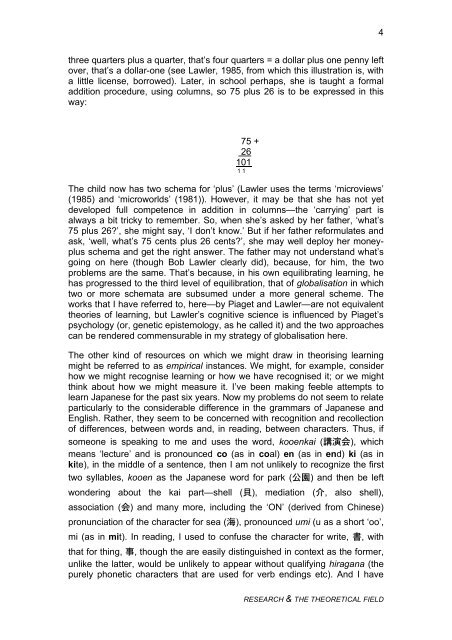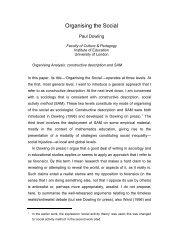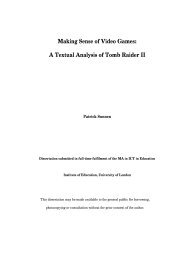Research and the Theoretical Field - Pauldowling.me
Research and the Theoretical Field - Pauldowling.me
Research and the Theoretical Field - Pauldowling.me
You also want an ePaper? Increase the reach of your titles
YUMPU automatically turns print PDFs into web optimized ePapers that Google loves.
4<br />
three quarters plus a quarter, that’s four quarters = a dollar plus one penny left<br />
over, that’s a dollar-one (see Lawler, 1985, from which this illustration is, with<br />
a little license, borrowed). Later, in school perhaps, she is taught a formal<br />
addition procedure, using columns, so 75 plus 26 is to be expressed in this<br />
way:<br />
75 +<br />
26<br />
101<br />
1 1<br />
The child now has two schema for ‘plus’ (Lawler uses <strong>the</strong> terms ‘microviews’<br />
(1985) <strong>and</strong> ‘microworlds’ (1981)). However, it may be that she has not yet<br />
developed full competence in addition in columns—<strong>the</strong> ‘carrying’ part is<br />
always a bit tricky to re<strong>me</strong>mber. So, when she’s asked by her fa<strong>the</strong>r, ‘what’s<br />
75 plus 26’, she might say, ‘I don’t know.’ But if her fa<strong>the</strong>r reformulates <strong>and</strong><br />
ask, ‘well, what’s 75 cents plus 26 cents’, she may well deploy her moneyplus<br />
schema <strong>and</strong> get <strong>the</strong> right answer. The fa<strong>the</strong>r may not underst<strong>and</strong> what’s<br />
going on here (though Bob Lawler clearly did), because, for him, <strong>the</strong> two<br />
problems are <strong>the</strong> sa<strong>me</strong>. That’s because, in his own equilibrating learning, he<br />
has progressed to <strong>the</strong> third level of equilibration, that of globalisation in which<br />
two or more schemata are subsu<strong>me</strong>d under a more general sche<strong>me</strong>. The<br />
works that I have referred to, here—by Piaget <strong>and</strong> Lawler—are not equivalent<br />
<strong>the</strong>ories of learning, but Lawler’s cognitive science is influenced by Piaget’s<br />
psychology (or, genetic epistemology, as he called it) <strong>and</strong> <strong>the</strong> two approaches<br />
can be rendered com<strong>me</strong>nsurable in my strategy of globalisation here.<br />
The o<strong>the</strong>r kind of resources on which we might draw in <strong>the</strong>orising learning<br />
might be referred to as empirical instances. We might, for example, consider<br />
how we might recognise learning or how we have recognised it; or we might<br />
think about how we might <strong>me</strong>asure it. I’ve been making feeble attempts to<br />
learn Japanese for <strong>the</strong> past six years. Now my problems do not seem to relate<br />
particularly to <strong>the</strong> considerable difference in <strong>the</strong> grammars of Japanese <strong>and</strong><br />
English. Ra<strong>the</strong>r, <strong>the</strong>y seem to be concerned with recognition <strong>and</strong> recollection<br />
of differences, between words <strong>and</strong>, in reading, between characters. Thus, if<br />
so<strong>me</strong>one is speaking to <strong>me</strong> <strong>and</strong> uses <strong>the</strong> word, kooenkai (), which<br />
<strong>me</strong>ans ‘lecture’ <strong>and</strong> is pronounced co (as in coal) en (as in end) ki (as in<br />
kite), in <strong>the</strong> middle of a sentence, <strong>the</strong>n I am not unlikely to recognize <strong>the</strong> first<br />
two syllables, kooen as <strong>the</strong> Japanese word for park () <strong>and</strong> <strong>the</strong>n be left<br />
wondering about <strong>the</strong> kai part—shell (), <strong>me</strong>diation (, also shell),<br />
association () <strong>and</strong> many more, including <strong>the</strong> ‘ON’ (derived from Chinese)<br />
pronunciation of <strong>the</strong> character for sea (), pronounced umi (u as a short ‘oo’,<br />
mi (as in mit). In reading, I used to confuse <strong>the</strong> character for write, , with<br />
that for thing, , though <strong>the</strong> are easily distinguished in context as <strong>the</strong> for<strong>me</strong>r,<br />
unlike <strong>the</strong> latter, would be unlikely to appear without qualifying hiragana (<strong>the</strong><br />
purely phonetic characters that are used for verb endings etc). And I have<br />
RESEARCH & THE THEORETICAL FIELD




